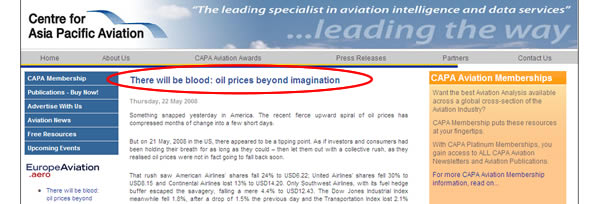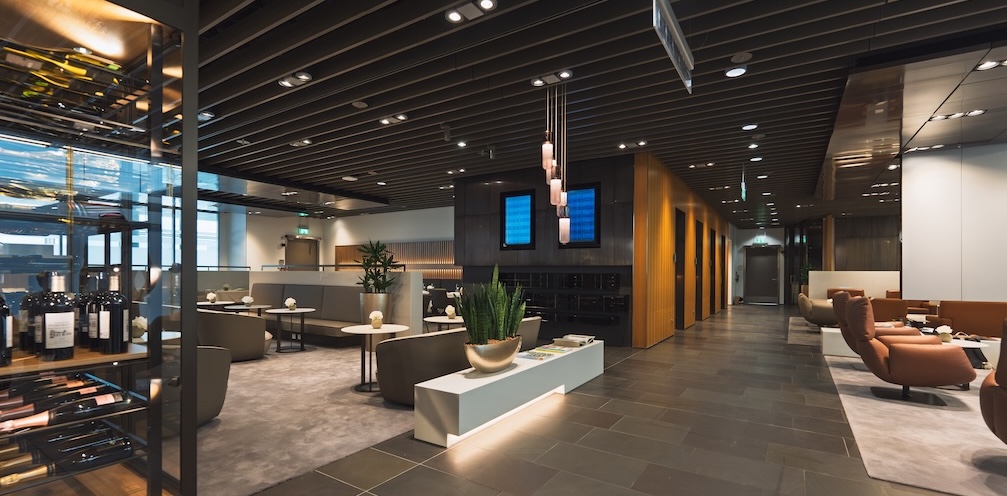 |
A stark headline – but in metaphorical terms at least CAPA seems sure to be right |
INTERNATIONAL. In a dramatic day for the world’s aviation sector, stocks in a number of US carriers tumbled yesterday in the wake of rocketing fuel costs and American Airlines announced the introduction of a US$15 charge for the first piece of checked luggage.
Oil has risen +19% this month amid supply constraints and demand growth and is set to climb much higher according to analysts.
“˜There will be blood’ was today’s dramatic headline in the European Airline Daily published by respected analyst Centre for Asia Pacific Aviation,(www.centreforaviation.com) as it assessed the likely impact of Wednesday’s jump in the price of oil to US$133.17 a barrel, up US$4.19.
 |
How high can it go? Now almost “beyond imagination” at US$133 a barrel, oil could reach US$200 in coming months |
American Airlines shares hit a five-year low, falling -24% to US$6.22, amid news of the latest oil price hike and a worsening of the US economic outlook.
Shares of United Airlines parent UAL Corp also slumped by -30% to US$8.15, reported to be the lowest level since the company emerged from bankruptcy in early 2006. Shares of US Airways Group fell -22% to US$5.35, a five-year low.
American Airlines announced yesterday it would slash its domestic flight schedule by up to -12% in the fourth quarter. And in a drastic step that underlines the gravity of the situation, it announced the introduction of a US$15 charge from 15 June on all passengers’ first piece of checked luggage. That follows the carrier’s decision two weeks ago to charge US$25 for a second bag.
COMMENT: What are the repercussions for travel retail of one of the aviation sector’s worst-ever crises? That question now has to be addressed urgently by every player in the business: retailer, food & beverage operator, airport commercial executive, inflight concessionaire, brand company – or media house.
Travel retail exists as a sub-component of two key “˜parent’ industries – travel & tourism and aviation. The second is currently taking a pounding. The impact on the former is so far muted. The critical question for travel retail relates to when, if or how severely the fuel crisis – and the related economic concerns being driven largely out of the US – impact on travel demand and consumer confidence.
 |
Drastic measures for drastic times: American Airlines is fighting for its commercial life |
Thus far travel retail has remained surprisingly immune from the wider economic and aviation industry climate. But if the US$200 a barrel prospect is real, then that means many things – rising ticket prices; additional passenger levies such as those just introduced by American Airlines on checked luggage; and reductions in routes and capacity.
Combined with any prolonged decline in consumer confidence – which will clearly vary heavily by country – that may spell not only fewer passengers but a reduced focus on ancillary, discretionary spending by those who travel.
Travel retail’s most enduring – and, if you’re in the business, endearing – quality, that of resilience, is set to face one of its toughest tests over the coming months. Things could get extremely rough.
Here is a round-up of reaction from analysts, media and business:
AIR CANADA: Oil at US$130 a barrel will cut into air travel demand this year and if the price goes higher Air Canada will have to rely on fuel surcharges to maintain margins, CEO Montie Brewer said after yesterday’s annual meeting in Montreal. “We’re moving towards two-tier ticket pricing, one tied to operating costs and the other geared to fuel prices,” he added. [Source: The Gazette]
AMR Corp (parent company of American Airlines): “There is no sugar-coating the fact we are facing an extraordinarily difficult economic environment. The industry cannot continue in the current state.” – Gerard Arpey, Chief Executive
BLOOMBERG: Airlines have been hit by higher jet fuel costs. The price of the fuel, the largest expense at many airlines, has climbed +88% in the past year and traded at a record US$4.0592 a gallon in New York Harbor yesterday.
“Everyone’s jumped on the bandwagon,” said Anthony Nunan, Assistant general Manager for Risk Management at Mitsubishi Corp, Japan’s biggest trading company, in Tokyo. “There’s agreement that US$200 [a barrel] is possible and that’s getting more people into the market. We have very little supply cushion going forward and that’s playing into the minds of investors.”
Centre of Asia Pacific Aviation: In a superbly erudite piece of analysis, (see www.centreforaviation.com for full report) CAPA said: “Something snapped yesterday in America. The recent fierce upward spiral of oil prices has compressed months of change into a few short days. But on 21 May, 2008 in the US, there appeared to be a tipping point. As if investors and consumers had been holding their breath for as long as they could – then let them out with a collective rush, as they realised oil prices were not in fact going to fall back soon.
“American Airlines also announced schedule reductions and a capacity cutback of -12% by the fourth quarter, as it fought to reduce costs at US$130-plus oil prices. It will only be a matter of days before other similar announcements are made, as US airlines ground some of their geriatric fleets.
“It would be unwise to expect that European airlines will be immune from these forces today when markets open, even where Air France-KLM reports a strong result. If in fact 21 May does represent one of those points in time when overall situations are re-evaluated, then the US’ pain will not be contained geographically.
“When Ryanair, an airline with among the best margins in Europe, predicts it will no longer be profitable at oil prices beyond US$135, it is time to start implementing Plan B. It is not only the higher cost base, but the compression of demand caused by higher transport prices and the slowing economy that creates the pressure.
“Airlines with thin margins have two options: lose money, or reduce flying. The first aircraft to be grounded will be the oldest. The first routes to go will be the lowest yielding. The logic and the mathematics are simple.
“Airline boardrooms worldwide will now be forced to give serious consideration to capacity cuts, even where they are not yet in financial danger territory. Shareholders will now demand that.”
LOS ANGELES TIMES: “Other airlines are expected to take additional steps to fight the twin curses of rising oil prices and a weak economy, increasing prospects for higher fares and crowded planes as the busy summer travel season kicks into gear with the upcoming Memorial Day weekend. Already, domestic airfares for summer travel are up 20% compared with a year ago. American Airlines said rising oil prices had increased its expected annual fuel costs by nearly US$3 billion since the start of the year.”
SOUTHWEST AIRLINES: “With fuel prices where they are, it’s a real threat to commercial aviation in America. All airlines, not just Southwest, are doing a good job controlling costs. But if you get your costs down -10% and fuel rises -80%, you’re not making any headway.” – Retiring Chairman Herb Kelleher [Source: USA Today]
[comments]
Your post will appear – once approved – in The Moodie Forum on our home page
MORE STORIES ON THE RISING COST OF FUEL
Dollar tumbles, Asian stocks fall, oil surges as US credit crisis threatens world economy – 17/03/08




